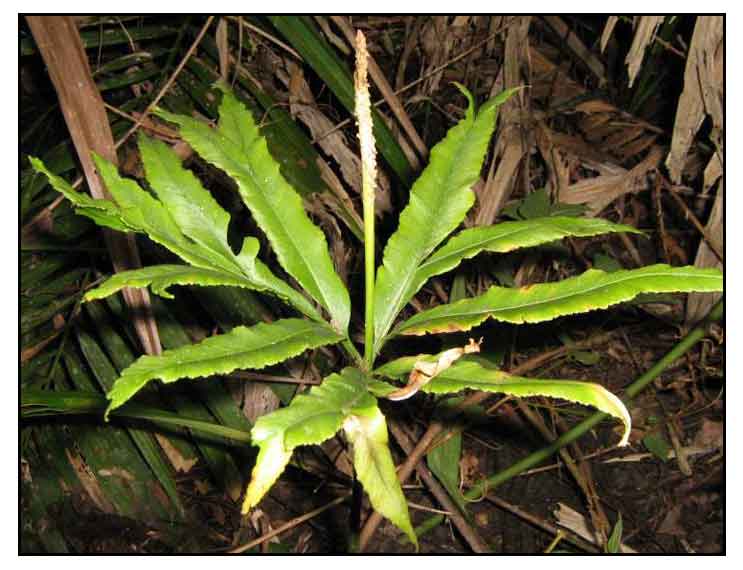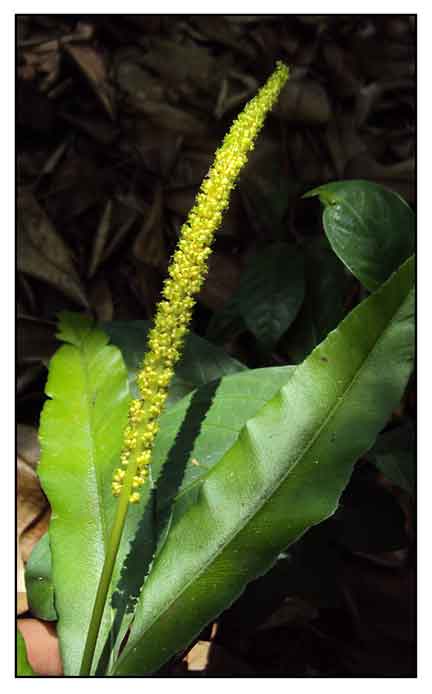|
 Botany Botany
Tukod-langit is a terrestrial, herbaceous stipitate fern, growing a foot or more in moist ground. Rhizomes are short, thick, and creeping,
Stipes are erect, 15 to 30 centimeters long. Fronds grow singly from the underground rhizomes, and the appearance is characteristic. Leaf blade spreads out almost horizontally, resembling an umbrella, hence the common name. It has three segments, each of which may be divided into two to five parts. Ultimate segments are 7 to 15 centimeters long, and 2 to 4 centimeters wide, and lanceolate. Mature leaves have a spike, 7 to 20 centimeters long, that extends upward from the leaf stalk, roughly following the latter in length. Upper portion of the spike contains the spores.
Distribution
- In open bushy places near sea
level, in moist ground, especially along the banks of streams.
- Often found in thickets, around bamboo clumps.
- New fronds usually initiated at the beginning of the rainy
season.
- Occurs at low altitudes from India, Sri Lanka, China and Taiwan, throughout Southeast Asia to tropical Australia.
 Constituents Constituents
- Studies yielded stilbenes and flavonoids with antioxidant activities.
- Yields four flavonoids -- ugonin A, B, C, and D, stigmasterol, fucosterol and dulcitol.
- Study of purified rhizomes isolated 8 new prenylated flavonoids, ugonins M-T (1-8), together with five known compounds, ugonins J−L (9−11), 5,4′-dihydroxy-4′′,4′′-dimethyl-5′′-methyl-5′′H-dihydrofurano [2′′,3′′:6,7] flavanone, and quercetin. (see study below) (6)
Properties
- Expectorant, good antidote for snakebites,
antiasthmatic.
- Considered aperient, aphrodisiac.
- Studies have suggested
antioxidant, neuroprotective, aphrodisiac, anti-inflammatory, hepatoprotective, cytotoxic, bone promoting, antidiabetic, antihyperuricemic properties.
Parts
utilized
· Rhizome.
· Wash and dry under the sun.
- Use rhizomes for propagation; preferably
in shaded and moist area.
Uses
Nutritional
- Young leaves popular as salad vegetable.
- Young, cooked petioles eaten as substitute for asparagus.
(17)
- Excellent source of phosphorus and iron; a fair source of calcium.
Folkloric
· For coughing due to tuberculosis,
asthma, poisonous snakebites: boil 6 to 10 grams dried drug in a cup of
water and drink the decoction.
· For snakebites: crush the fresh plant and poultice the wound.
· For fractures and bone strengthening.
· Rhizome is chewed with betel for whooping cough.
· In India, used
in Kerala for the treatment of hepatic disorders; rhizome also used for curing
impotency; rhizome is chewed with areca for whooping cough.
- Decoction of rhizome used for treatment of impotency. Leaf juice used to treat blisters of the tongue. Powdered rhizome in cow's milk used as brain tonic and to increase vitality. Decction of rhizome boiled in cow's milk mixed with black pepper used for treatment of leucorrhea.
Rhizome powder giver for spermatorrhea and for improving memory. (18)
· In Bangladesh, Khagrachari tribe use the plant to stop hemorrhages. Decoction of rhizome used in impotency. In Bandarban, root juice used with other plants for treatment of jaundice. Leaf Juice used for tongue blisters.
· In China, rhizome is used as antipyretic and antiphlogistic.
· In Malaysia, rhizome
used as a tonic. Decoction of leaves used as tonic after childbirth. Rhizome mixed with Piper betel for cough and venereal diseases.
· In Java, used
for dysentery, catarrh, phthisis. In early stages of tuberculosis, porridge is prepared from the rhizome, eaten and also spread over the chest.
(17)
· In the Moluccas,
used to relieve constipation. Rhizome eaten with betel for whooping cough. In Malaysia,
used as a tonic. The Sakai use it to treat syphilis. (17)
· The Khumi tribe in Bangladesh used a mixture of roots of H. zeylanica and Lygodium flexuosum for treatment of fever, red urine, and urinary bladder pain. (25)
Others
· Crafts: In the Philippines and Java, petioles of old leaves used for wickerwork and handicraft. (17)
Studies
• Hepatoprotective / Rhizome:
Study of ethanolic extracts of rhizomes of HZ showed significant hepatoprotective
effect against CCl4-induced damage liver damage in rats and presents
scientific rational for its folkloric use in liver diseases.
(1)
• Antioxidants / Flavonoids / Rhizomes:
Study yielded eight flavonoids, ugonins E-L (1-8) from the rhizomes
of HZ. Compounds 6, 7 and 8 showed significant antioxidant activity. (2)
• Antioxidants / Stilbenes / Rhizomes: Study yielded three new cyclized stilbenes, ugonstilbene A,. B and
C which exhibited moderate antioxidant activity. (3)
• Neuroprotective / Rhizomes:
Study has isolated Ugonin K, a flavonoid from the rhizomes of H zeylanica. Results suggest ugonin K has neuroprotective activity through activation of ERK1/2 and PI3K?Akt signal pathways which protects against H2O2-induced apoptosis. (4)
• Anti-Inflammatory / Flavonoids:
Study isolated 8 new prenylated flavonoids, ugonins M-T together with five known compounds, ugonins J−L (9−11), 5,4′-dihydroxy-4′′,4′′-dimethyl-5′′-methyl-5′′H-dihydrofurano[2′′,3′′:6,7]flavanone, and quercetin. Compounds 1, 3, 5, 7, 8, and 11 showed inhibition of superoxide anion generation and elastase release by human neutrophils in response to FMLP/CB. (6)
• Aphrodisiac / Rhizome:
Administration of a methanol extract of H. zeylanica rhizome to male mice significantly stimulated the sexual behavior as shown by increase in number of mounts, mating and reproductive performance. (7)
• Antioxidant Flavonoids:
Eight flavonoids, ugonins E-L were isolated from the rhizomes of Helminthostachys zeylanica. Compounds 3-8 were evaluated for their antioxidative activity in a DPPH assay. Compounds 6,7 and 8 were more active than Trolox. (9)
• Ugonin J Flavonoid / Antioxidant:
Study isolated Ugonin J from the dried rhizomes of H. zeylanica. A previous study has shown antioxidant activity with Ugonin J, K, and L. (13)
• Cytotoxicity / Toxicity of Combinations:
Three plants -- Tacca integrifolia, Helminthostachys zeylanica, and Eurycoma longifolia. All three were cytotoxic to human cell lines, Hep2 and HFL1. A combined extract of E. longifolia and H. zeylanica was more cytotoxic than a single extract on Hep2 cell line. Study suggests there is higher toxicity risk of consuming combination of H. zeylanica with either T. integrifolia or E. longifolia, and products using these combinations should be avoided. (14)
• Ugonin K Flavonoid / Promotion of Osteoblastic Differentiation and Mineralization:
Study showed a potential anabolic effect of ugonin K on bone probably through activation of p38- and ERK-mediated Runx2 and osterix expressions to induce synthesis of osteoids and formation of bone nodule. (15)
• Subchronic Toxicity Test / Rhizome: Study evaluated the sub-chronic toxicity of ethanol extract of rhizome on albino rats, Rattus noverticus, Wistar strain. Doses of 68, 136, 272, and 584 mg/kbw were used. Results showed no toxic symptoms, using parameters of body weight, hematologic and biochemical properties, macroscopic organs and relative organ weight. (19)
• Antidiabetic / Ugonins J ad K / Roots: Study of roots isolated two flavonoid compounds identified as ugonin J and K, which were evaluated for antidiabetic activity using α-glucosidase inhibitor assay. Results showed moderate activity with IC50s of 273,13±0,402 ppm and 138,21±0,263 ppm for Ugonin J and K, respectively. Results suggest plants can be used traditionally as antidiabetic medicine. (20)
• Metabolic Disorders / Invention: Invention presents the application of a formula consisting of H. zeylanica, ugonin and a compound for treating or preventing metabolic diseases, viz., excessive fat accumulation, fatty liver, hepatic steatosis, cirrhosis, dyslipidemia, liver cancer, among others. (21)
• Ugonin M / Prevents LPS-Induced Acute Lung Injury: Study evaluated the effect of Ugonin M, a unique flavonoid isolated from H zeylanica in an LPS-induced acute lung injury model. Ugonin M inhibited the production of pro-inflammatory mediators i.e., NO, TNF-α, IL-1ß, and IL-6 and ameliorated the severity of pulmonary edema. It also significantly suppressed LPS-stimulated protein levels of iNOS and COX-2. It suppressed NF-kB and MAPK activation via degradation of NF-kB and IkB-a and inhibited protein expression level of TLR4. Results suggest Ugonin M could be one of the major components of H. zeylanica in the treatment of inflammatory disorders. (22) H. zeylanica water extract reduced lung injury in mice by reducing oxidative stress and inflammatory responses in LPS-induced acute lung injury in mice. The HZW also reduced inflammatory responses in human lung epithelial cells. (28)
• Alleviation of Hepatic Steatosis and Insulin Resistance: Study evaluated the effect of HZ on high fat diet induced obesity, nonalcoholic fatty liver disease (NAFLD) and insulin resistance. Major components of the extract were ugonins J and K. Results showed protection of the high-fat diet fed mice from hyperlipidemia and hyperglycemia. Fat accumulation was reduced int he liver. Also, insulin sensitivity-associated index, which evaluated insulin function, was also significantly restored. (23)
• Cyclohexylmethyl Flavonoids / Suppression of Breast Cancer Stem Cells: Study evaluated natural cyclohexylmethyl flavonoids isolated from rhizomes of H. zeylanica, of which five were identified that can inhibit expansion of NANOG cells. Among the flavonoids, ugonins J and K were able to suppress propagation of CD24 and CD44 breast cancer stem cells both in vivo and in vitro. Results showed the flavonoids can suppress propagation of breast cancer stem cells via downregulation of the pleuripotent gene NANOG involved in self-renewal of breast cancer stem cells. (24)
• Antihyperuricemic Effect / rhizome: Study on Swiss male mice evaluated the antihyperuricemic effect of ethanol extract of H. zeylanica compared to that of allopurinol, Results showed hypouricemic potency. Based on percentage of degradation of uric acid level and extract concentration, the ED50 value of the extract is 135.76 mg/kbw. (26)
• Suppressive Effect of Ugonin on Vascular Smooth Muscle Cells and Restenosis: Neointimal hyperplasia (restenosis) is primarily due to excessive proliferation and migration of vascular smooth muscle cells (VSMCs). Study evaluated the inhibitory effects and mechanisms of ugonin J on VSMC proliferation and migration and neointimal formation. Balloon angioplasty-induced neointimal formation was induced in rat carotid artery model. Ugonin J induced cell-cycle arrest at the G0/G1 phase and apoptosis to inhibit VSMC growth and exhibited marked suppressive activity on VSMC migration. It reduced expressions and activity levels of matrix metalloproteinase-2 and matrix metalloproteinase-9. Results suggest ugonin J has potential for application in the prevention of balloon injury-induced neointimal formation. (27)
Availability
Wild-crafted. |



